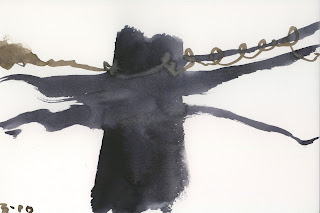Whats interesting for me about this image is the way the wave implies a circling of the mountain in the background (Mt. Fuji). Its not a circle completed, but one implied, and it has an interesting relative in the 5 yen coin, where a rice shoot is shown to be bent in the wind, creating, or reinforcing, the vacant center.
And what is the "vacant" center in the print? It is Mt. Fuji, the spiritual center of Japan, and perhaps its primary symbol. This print verifies the central role a "Great Wave" has in the history and making of the Japanese nation, as i alluded to in the first post, but beyond this narrative, there is another layer of information contained in this print that alludes to the fundamental quality of Japanese being. If one looks again at the print, Mt Fuji appears as any other mountain, but it differs greatly in its formality. Mt Fuji is a volcano, and as such may be said to be "empty" in the sense that it is but a conduit for the molten center of our planet. If one were to look down onto a volcano from above, Mt Fuji might appear as the coin does, with an empty center and full perimeter. In this sense, a volcano is the ideal iconic image of the history and collective experience of Japan, as it is simultaneously at peace in its harmonious, singular composition, and menacing in its reality as a volcano. It duels with itself in appearing to be central while simultaneously denying center, or rather presenting center as something empty, vacant. Many of Japan's sensibilities and customs come from this tension between center and perimeter, order and disorder; where often the perimeter is activated by en emptied center, and as i'll later demonstrate, the appearance of "empty" is anything but.
Roland Barthes explored this notion in his musings about Japanese train stations, which in his mind were the genuine "centers" of Japanese cities, rather than the Town Halls, Squares, and civic buildings of western cities. He noted that the train station, which was generally full of people and thus heavily populated, was in a constant state of flux between emptying and filling, much like a heart, filling with blood only to send it away. This state of flux makes it a very unique kind of "center" as it is one that does not hold its contents, but expels them, both inward and outward. It is a center that exists in and celebrates the moment, the moment of arrival and departure, rather than the passing of decades and centuries. This celebration of the moment over what elsewhere might take the form of a collective salute to history is also a very Japanese notion, and not unrelated its inclination to reset its calendar, or design with an acknowledgement of disorder, upon the arrival of epic "moments".





